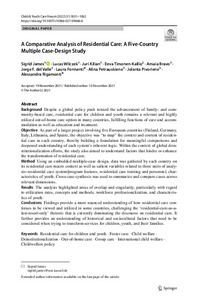| dc.date.accessioned | 2023-01-04T12:45:26Z | |
| dc.date.available | 2023-01-04T12:45:26Z | |
| dc.date.issued | 2021-12-13 | |
| dc.identifier | doi:10.17170/kobra-202211027062 | |
| dc.identifier.uri | http://hdl.handle.net/123456789/14329 | |
| dc.description.sponsorship | Gefördert im Rahmen des Projekts DEAL | ger |
| dc.description.sponsorship | This research was supported by the Erasmus+program. | eng |
| dc.language.iso | eng | eng |
| dc.rights | Namensnennung 4.0 International | * |
| dc.rights.uri | http://creativecommons.org/licenses/by/4.0/ | * |
| dc.subject | residential care for children and youth | eng |
| dc.subject | foster care | eng |
| dc.subject | child welfare | eng |
| dc.subject | deinstitutionalization | eng |
| dc.subject | out-of-home care | eng |
| dc.subject | group care | eng |
| dc.subject | international child welfare | eng |
| dc.subject | child welfare policy | eng |
| dc.subject.ddc | 300 | |
| dc.title | A Comparative Analysis of Residential Care: A Five-Country Multiple Case-Design Study | eng |
| dc.type | Aufsatz | |
| dcterms.abstract | Background
Despite a global policy push toward the advancement of family- and community-based care, residential care for children and youth remains a relevant and highly utilized out-of-home care option in many countries, fulfilling functions of care and accommodation as well as education and treatment.
Objective
As part of a larger project involving five European countries (Finland, Germany, Italy, Lithuania, and Spain), the objective was “to map” the context and content of residential care in each country, thereby building a foundation for meaningful comparisons and deepened understanding of each system’s inherent logic. Within the context of global deinstitutionalization efforts, the study also aimed to understand factors that hinder or enhance the transformation of residential care.
Method
Using an embedded multiple-case design, data was gathered by each country on its residential care macro context as well as salient variables related to three units of analysis–residential care system/program features, residential care training and personnel, characteristics of youth. Cross-case synthesis was used to summarize and compare cases across relevant dimensions.
Results
The analysis highlighted areas of overlap and singularity, particularly with regard to utilization rates, concepts and methods, workforce professionalization, and characteristics of youth.
Conclusions
Findings provide a more nuanced understanding of how residential care continues to be viewed and utilized in some countries, challenging the ‘residential-care-as-a-last-resort-only’ rhetoric that is currently dominating the discourse on residential care. It further provides an understanding of historical and sociocultural factors that need to be considered when trying to transform services for children, youth, and their families. | eng |
| dcterms.accessRights | open access | |
| dcterms.creator | James, Sigrid | |
| dcterms.creator | Wilczek, Lucas | |
| dcterms.creator | Kilian, Juri | |
| dcterms.creator | Timonen-Kallio, Eeva | |
| dcterms.creator | Bravo, Amaia | |
| dcterms.creator | del Valle, Jorge Fernández | |
| dcterms.creator | Formenti, Laura | |
| dcterms.creator | Petrauskiene, Alina | |
| dcterms.creator | Pivoriene, Jolanta | |
| dcterms.creator | Rigamonti, Alessandra | |
| dc.relation.doi | doi:10.1007/s10566-021-09666-6 | |
| dc.relation.projectid | project number: 2018–1-FI01-KA203-047242 | |
| dc.subject.swd | Hauspflege | ger |
| dc.subject.swd | Kind | ger |
| dc.subject.swd | Jugend | ger |
| dc.subject.swd | Fremdunterbringung | ger |
| dc.subject.swd | Kinderfürsorge | ger |
| dc.subject.swd | Entinstitutionalisierung | ger |
| dc.type.version | publishedVersion | |
| dcterms.source.identifier | eissn:1573-3319 | |
| dcterms.source.issue | Issue 6 | |
| dcterms.source.journal | Child & Youth Care Forum | eng |
| dcterms.source.pageinfo | 1031-1062 | |
| dcterms.source.volume | Volume 51 | |
| kup.iskup | false | |


